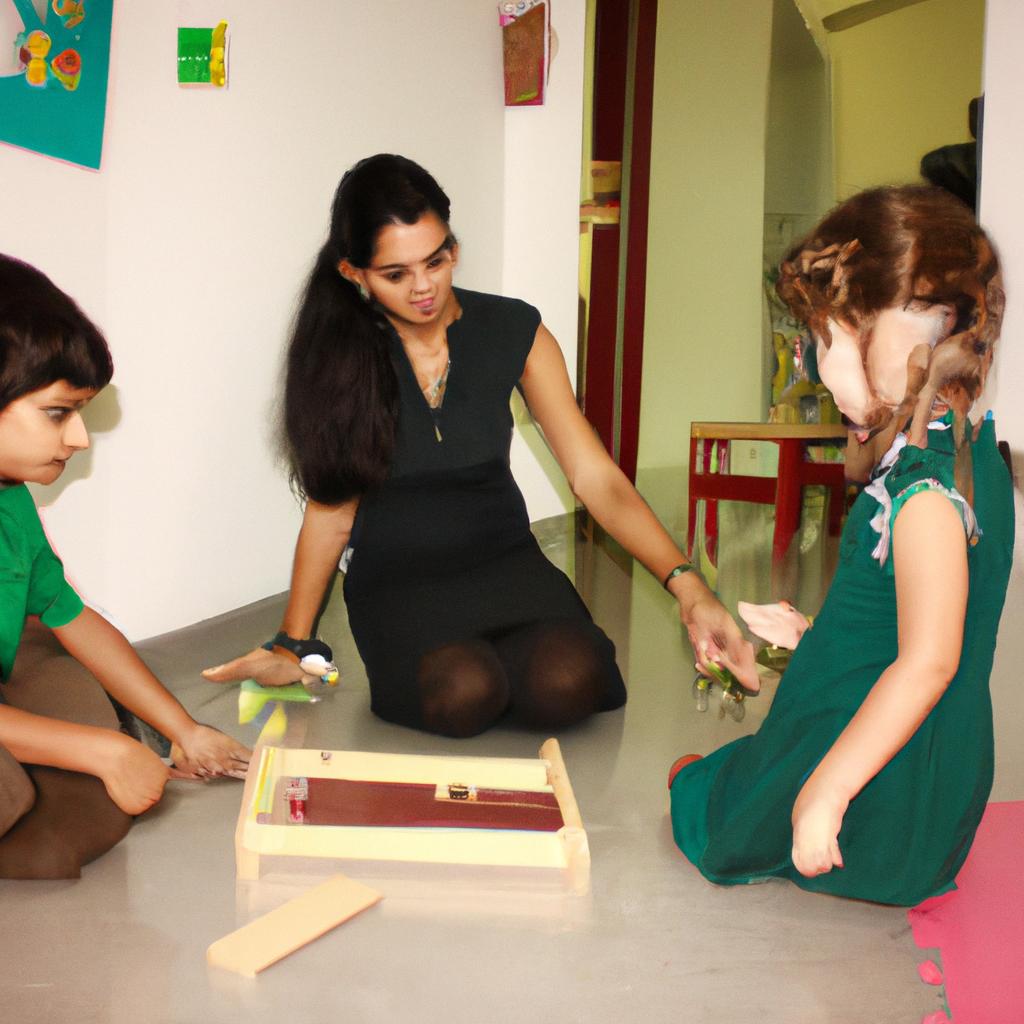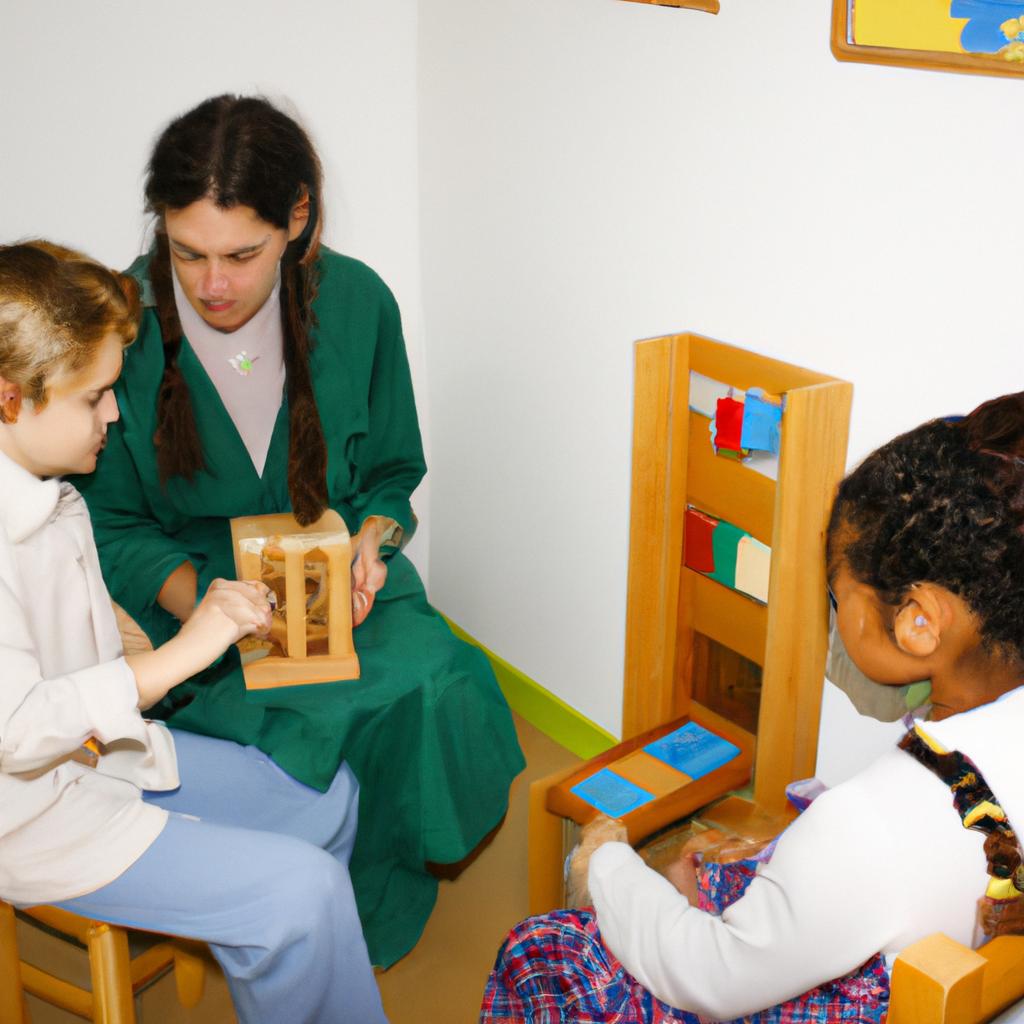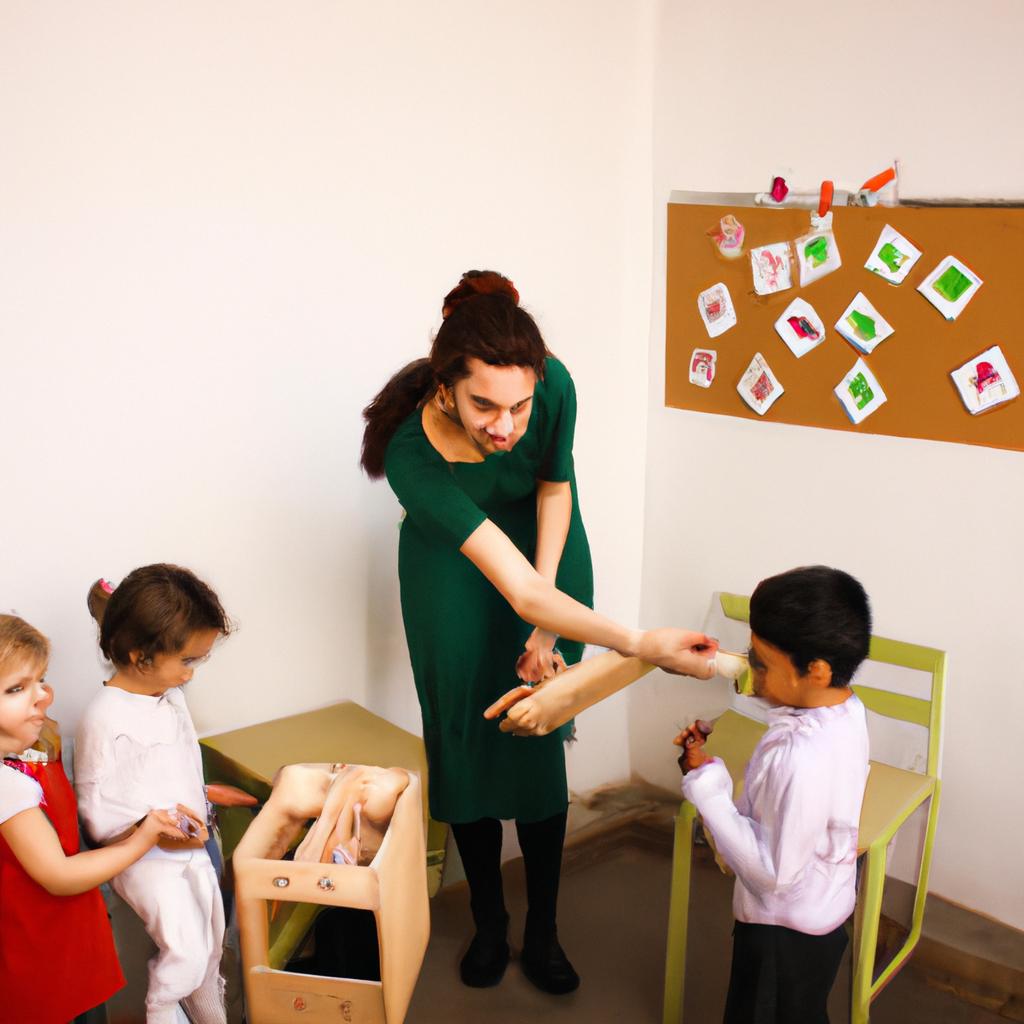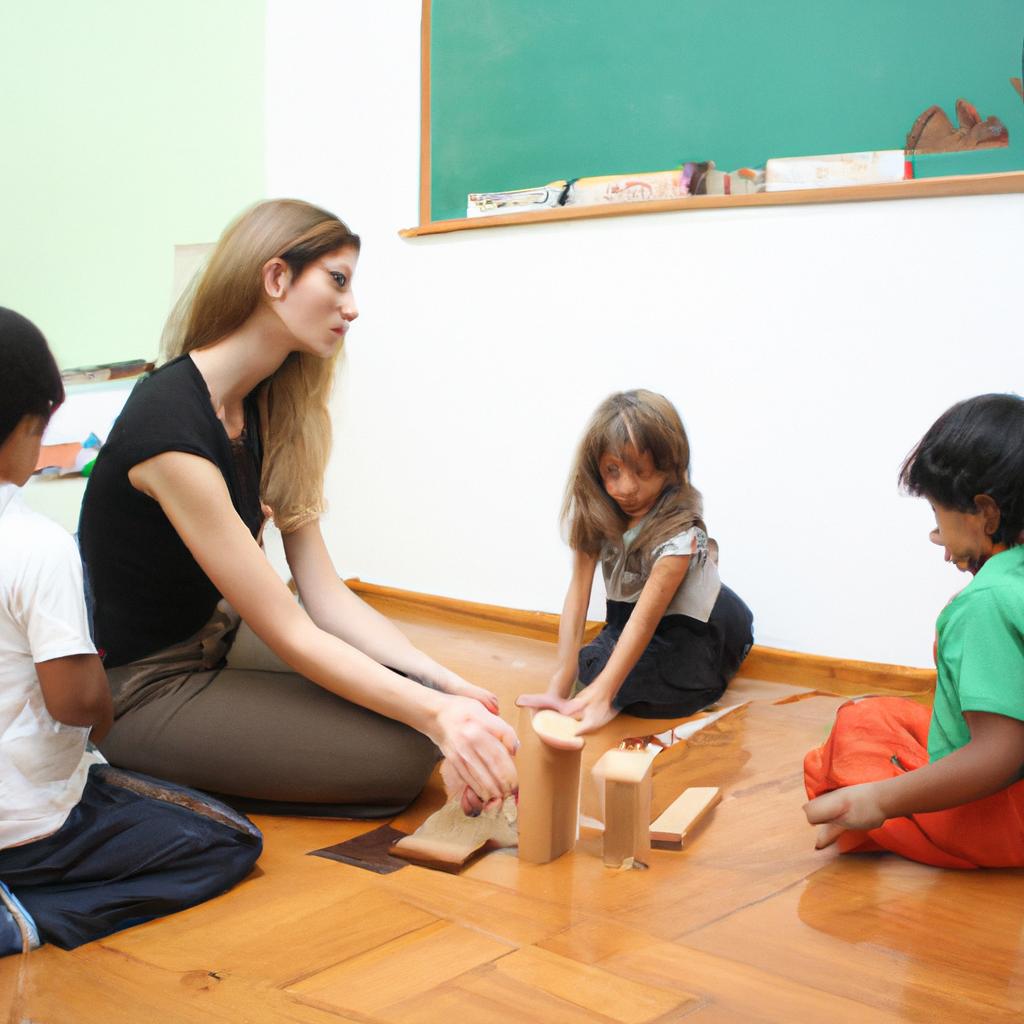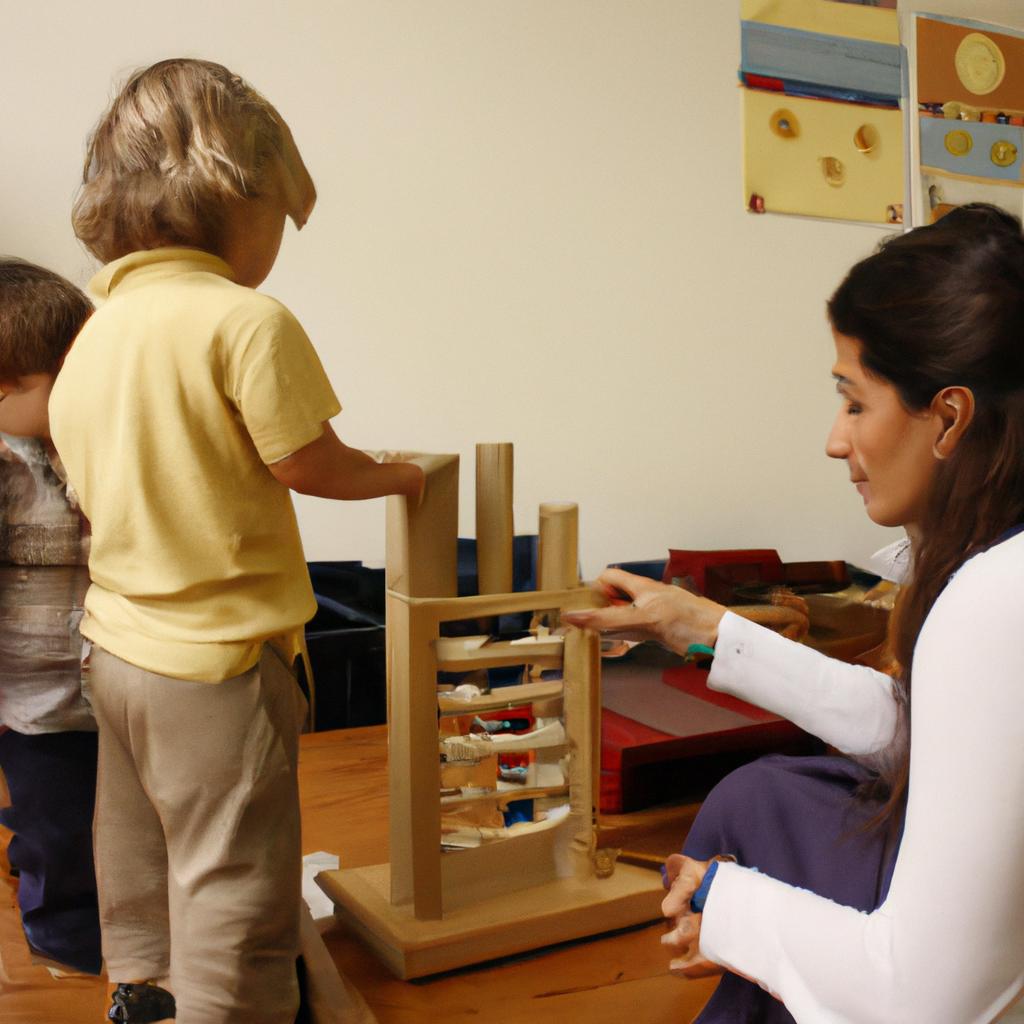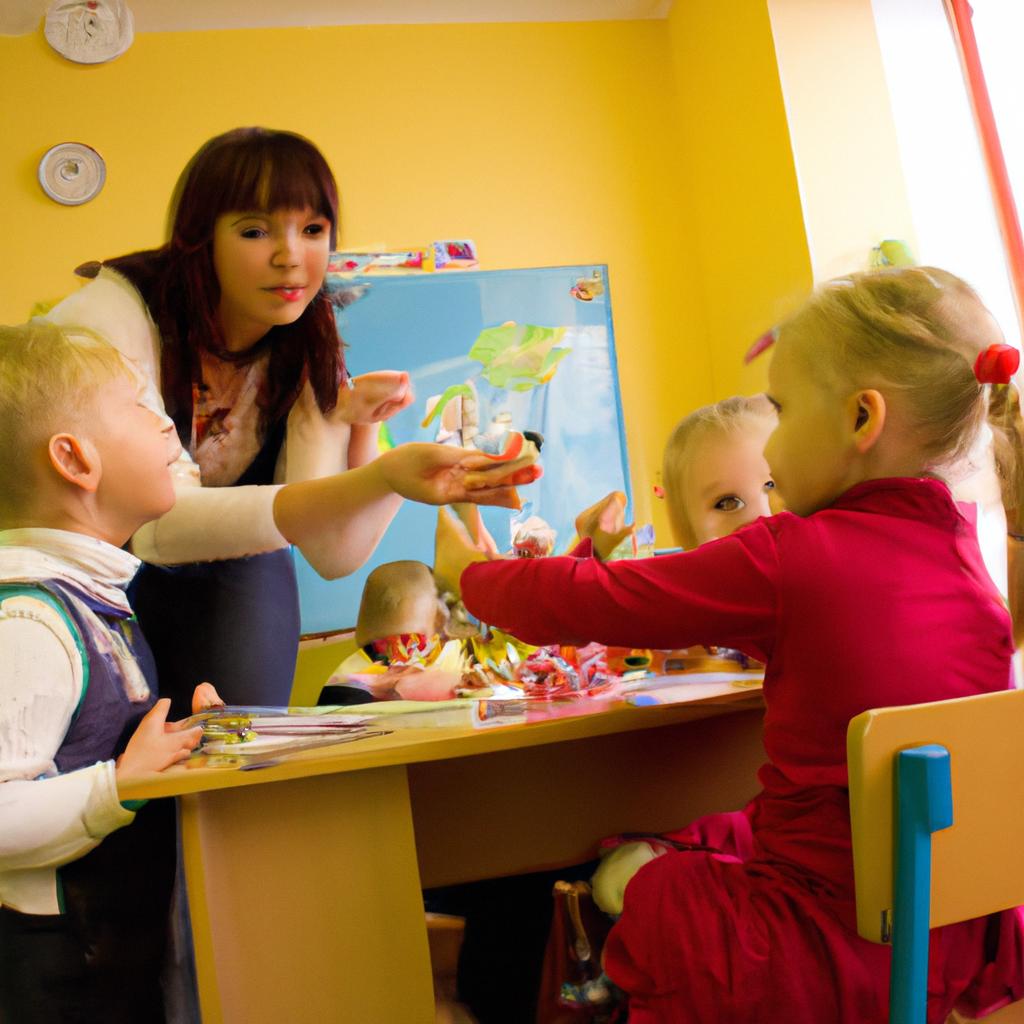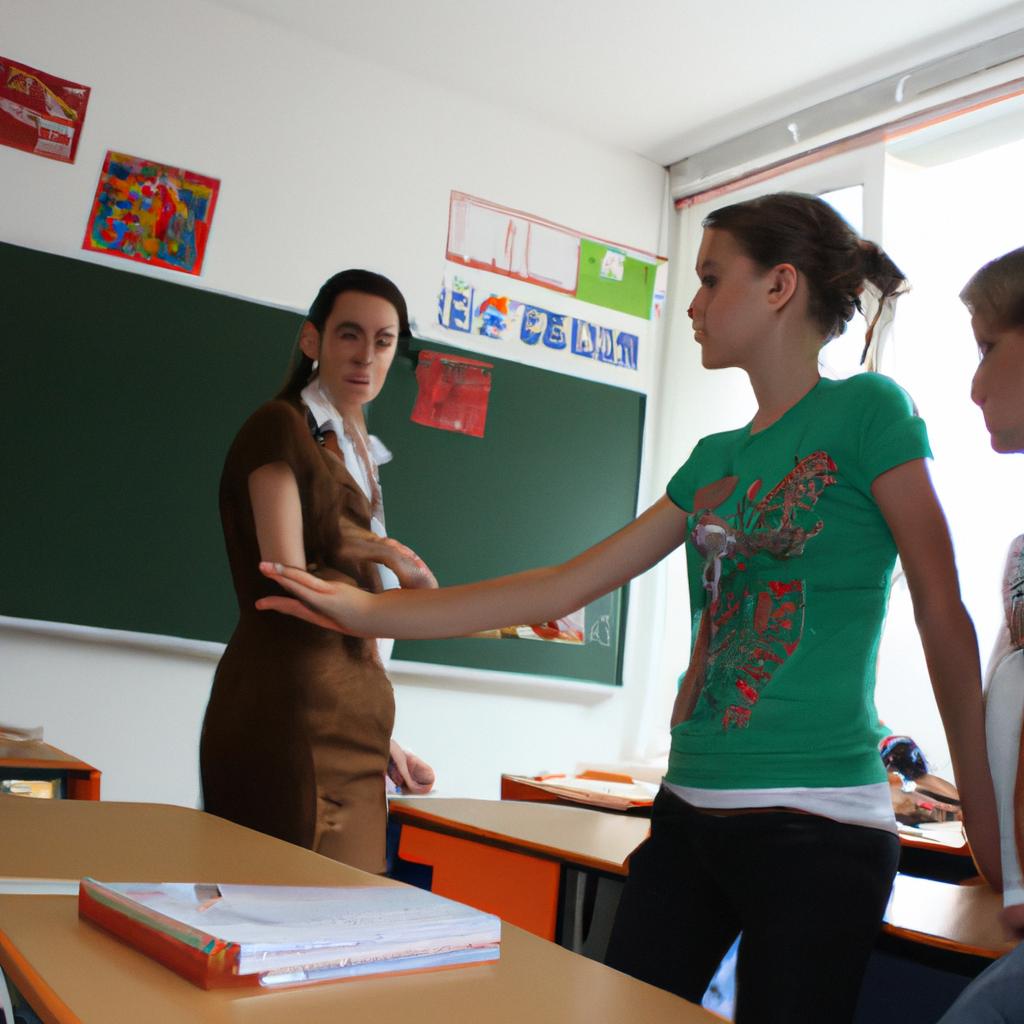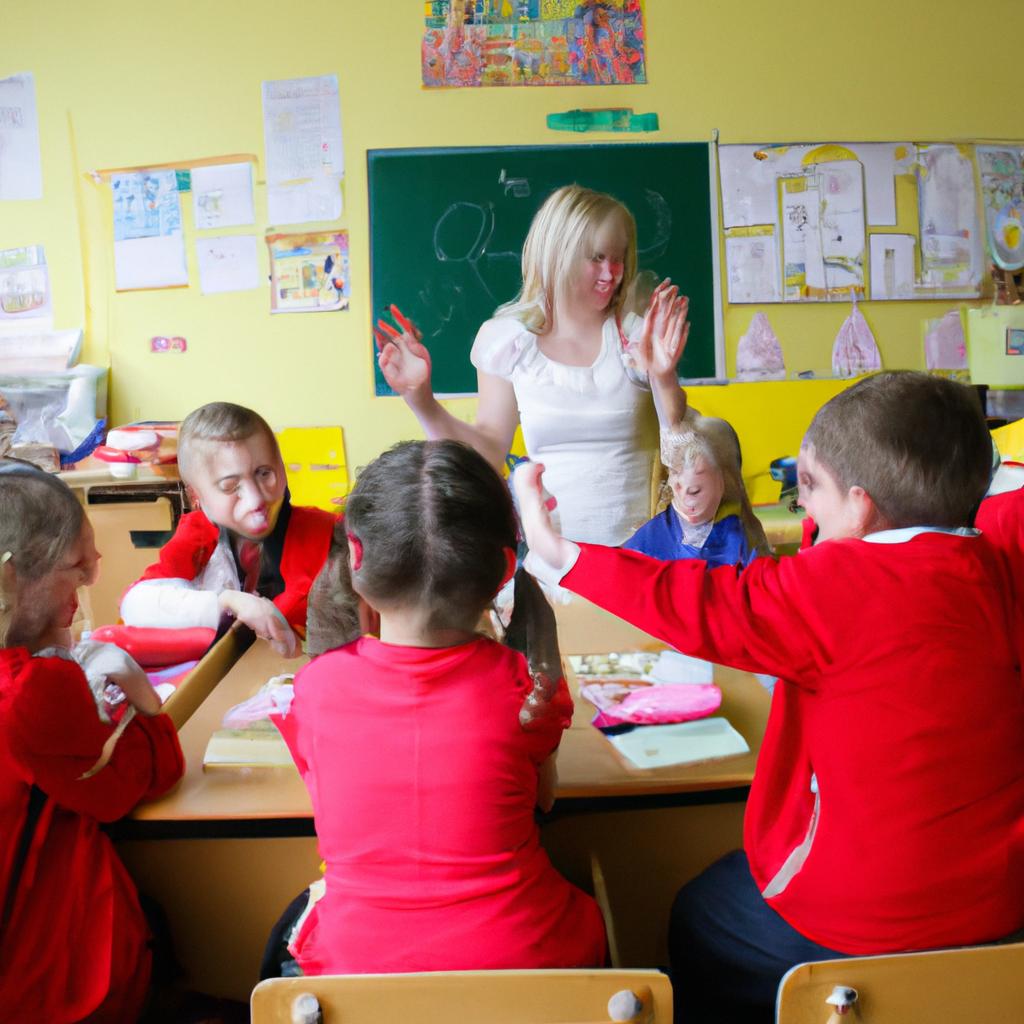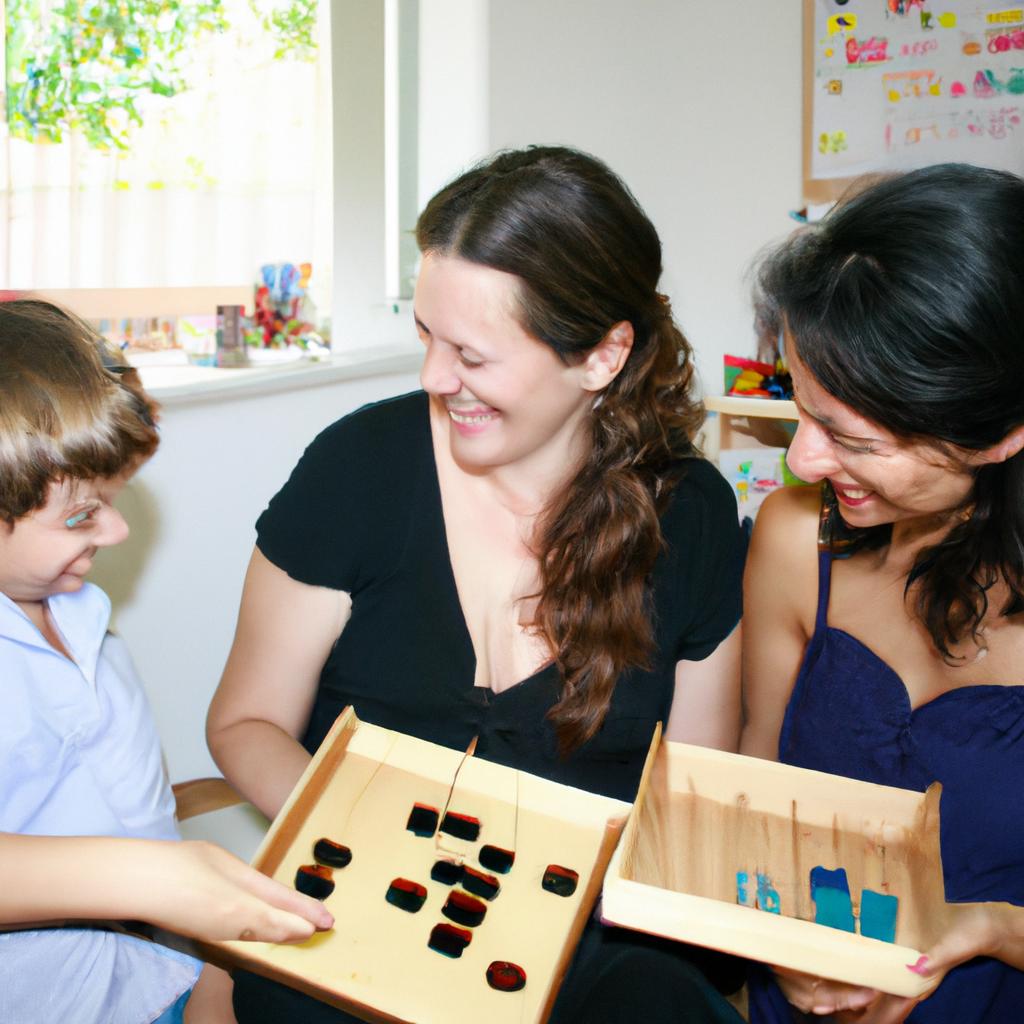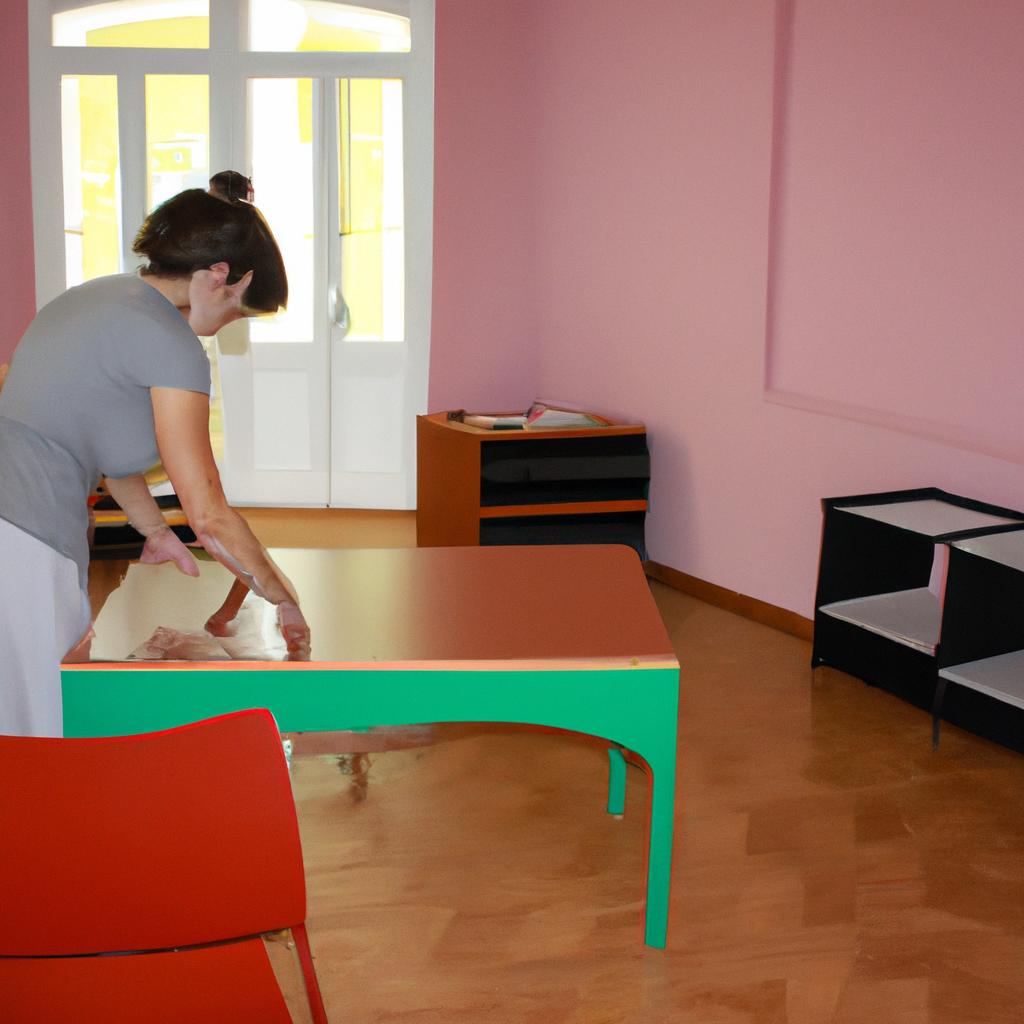Introduction
In the Montessori school context, the role of the teacher is instrumental in fostering an environment that supports student-centered learning and development. By embracing Maria Montessori’s educational philosophy, which emphasizes independence, freedom within limits, and respect for each child’s individuality, the Montessori teacher plays a crucial role as a facilitator and guide. This article aims to explore the multifaceted responsibilities of a Montessori teacher by examining their roles in creating prepared environments, observing and guiding students’ progress, and promoting social-emotional growth.
Imagine a scenario where a five-year-old child enters a Montessori classroom for the first time. Instead of being greeted with desks lined up in rows or teachers lecturing at the front of the room, they encounter shelves filled with enticing materials carefully arranged according to subject areas such as language, math, science, practical life skills, and cultural studies. The Montessori teacher has meticulously designed this prepared environment to foster curiosity and independent exploration. With an understanding that children learn best through hands-on experiences and self-directed activities, the teacher acts as an observer rather than a constant source of instruction. They observe each child’s unique interests, abilities, and challenges to provide tailored guidance that encourages intellectual growth while respecting their individual pace of learning.
The Montessori teacher’s role in the prepared environment goes beyond just setting up the materials. They ensure that the classroom is organized, clean, and aesthetically pleasing, creating an atmosphere that promotes concentration and order. The teacher also regularly rotates and introduces new materials to keep the environment fresh and engaging for the students.
In addition to creating a conducive physical space, the Montessori teacher serves as a guide in facilitating the child’s exploration and discovery. Rather than imposing their own agenda or directing every activity, they allow children to choose their work independently. This freedom within limits empowers students to take ownership of their learning journey while providing necessary structure and boundaries.
Observation is a key tool used by Montessori teachers to understand each student’s progress, interests, strengths, and areas requiring additional support. By keenly observing children at work, the teacher can identify when intervention or guidance is needed. They then step in with appropriate materials or lessons tailored to the individual student’s needs. This personalized approach helps foster intrinsic motivation and allows children to develop confidence in their abilities.
Furthermore, Montessori teachers play a crucial role in promoting social-emotional growth among students. They create an inclusive community where respect, empathy, and cooperation are valued. The teacher models positive behavior and encourages students to resolve conflicts peacefully through open communication and problem-solving skills.
Additionally, Montessori teachers foster independence by teaching practical life skills such as dressing oneself, preparing food, cleaning up after activities, and taking care of the environment. These skills not only contribute to a child’s self-confidence but also instill a sense of responsibility towards themselves and others.
In conclusion, the role of a Montessori teacher encompasses creating prepared environments that inspire independent exploration while providing guidance tailored to each child’s unique developmental needs. Through observation and personalization of instruction, these teachers empower students to become lifelong learners who possess strong academic skills and social-emotional intelligence. By embracing Maria Montessori’s educational philosophy, Montessori teachers play a vital role in nurturing the holistic development of young learners.
Observing student behavior and progress
Observing Student Behavior and Progress
One of the essential roles of a Montessori teacher is to observe student behavior and progress. Through careful observation, teachers can gain valuable insights into each child’s unique learning style, strengths, challenges, and areas for growth. For instance, imagine a hypothetical scenario where a teacher notices that a particular student excels in independent work but struggles with social interactions during group activities. This observation allows the teacher to tailor their approach and provide appropriate support to facilitate the student’s development in both areas.
To effectively observe student behavior and progress, Montessori teachers employ various techniques and strategies. These may include:
- Anecdotal Notes: Teachers take detailed notes on specific observations about individual students’ behaviors or actions during classroom activities.
- Checklists: Using predefined checklists, teachers track students’ mastery of skills or completion of tasks over time.
- Running Records: Teachers maintain running records by continuously documenting students’ behaviors, interactions, and accomplishments throughout lessons or playtime.
- Video Documentation: In some cases, teachers use video recordings as an additional tool for capturing moments of student engagement, collaboration, or problem-solving.
By utilizing these methods of observation consistently and thoughtfully, Montessori teachers can gather comprehensive information about each child’s progress while ensuring objectivity in assessment practices.
Ultimately, observing student behavior and progress serves as a foundation for planning engaging and purposeful activities that align with each child’s needs and interests.
Planning engaging and purposeful activities
Observing student behavior and progress is a crucial aspect of the Montessori teacher’s role, as it allows them to gain valuable insights into each individual child’s development. By closely observing students in the classroom, teachers can identify their strengths, weaknesses, and areas for growth. For example, let us consider a hypothetical case study: Sarah, a five-year-old student who struggles with fine motor skills but excels in problem-solving tasks. Through careful observation, the Montessori teacher notices this disparity and tailors activities to support Sarah’s fine motor development while nurturing her problem-solving abilities.
To effectively observe student behavior and progress, Montessori teachers employ various strategies and techniques:
- Anecdotal notes: Teachers take detailed notes on specific behaviors or achievements observed during class time.
- Checklists: These tools help keep track of students’ mastery of certain skills or concepts.
- Video recordings: Recording classroom sessions provides an opportunity for further analysis and reflection on student interactions and engagement.
- Collaborative discussions: Regular meetings with colleagues allow teachers to share observations, seek input, and brainstorm strategies for supporting individual students.
By employing these methods of Observation, Montessori teachers gain a comprehensive understanding of each student’s unique learning journey. This knowledge enables them to plan engaging and purposeful activities that cater to individual needs.
In order to ensure that every child receives the best educational experience possible, Montessori teachers carefully design activities tailored to meet individual student needs. They take into account factors such as learning style preferences or developmental level when planning lessons. Additionally, they understand that some children may require additional support or challenges based on their abilities.
| Strengths | Weaknesses | Areas for Growth |
|---|---|---|
| Problem-solving skills | Fine motor skills | Social-emotional development |
| Critical thinking abilities | Language acquisition | Creative expression |
| Independent work habits | Attention span | Physical coordination |
This three-column, four-row table highlights the diverse range of strengths, weaknesses, and areas for growth that Montessori teachers consider when planning activities. By addressing these different aspects of student development, they can create a holistic learning environment that nurtures each child’s potential.
As we move forward in exploring The Role of the Montessori Teacher, it becomes evident that tailoring instruction to individual student needs is paramount. This involves not only observing behavior and progress but also using those observations to inform instructional decisions. By taking into account students’ unique abilities, interests, and challenges, Montessori teachers foster an inclusive and supportive classroom where every child has the opportunity to thrive academically and personally.
Tailoring instruction to individual student needs
Building on the importance of planning engaging and purposeful activities, it is crucial for Montessori teachers to tailor their instruction to meet the unique needs of each individual student. By recognizing that every child learns differently, educators can create an inclusive learning environment that fosters growth and development. Let us consider a hypothetical example to understand the significance of this approach.
Example: Imagine a Montessori classroom where one student, Emily, struggles with reading comprehension while another student, James, excels in mathematics but finds social interactions challenging. The role of the Montessori teacher in this context becomes essential in ensuring that both students receive customized support to maximize their potential.
To effectively tailor instruction to individual student needs, Montessori teachers employ various strategies such as:
- Conducting ongoing assessments: Regular assessment allows teachers to identify areas where students require additional guidance or intervention.
- Providing differentiated materials and resources: Offering a range of materials at different levels enables students to progress at their own pace and engage with content that matches their abilities.
- Implementing flexible grouping: Creating small groups based on students’ strengths and weaknesses promotes collaborative learning experiences wherein they can learn from and support one another.
- Adapting teaching methods: Utilizing diverse instructional approaches ensures that all learners have access to information through visual aids, hands-on activities, auditory cues, or technology-based tools.
By tailoring instruction according to individual student needs, Montessori teachers promote inclusivity within their classrooms. This personalized approach not only enhances academic performance but also nurtures emotional well-being by addressing specific challenges faced by each learner. It empowers students like Emily and James mentioned earlier to overcome hurdles and reach their full potential.
Transition into subsequent section about “Facilitating discovery-based learning experiences”: In addition to tailoring instruction, facilitating discovery-based learning experiences plays a vital role in fostering independent thinking skills among Montessori students.
Facilitating discovery-based learning experiences
Tailoring instruction to individual student needs is a crucial aspect of the Montessori teaching approach. By recognizing and addressing the unique requirements and learning styles of each child, teachers can create an optimal environment for their growth and development. For instance, imagine a hypothetical scenario where a Montessori teacher has a classroom with diverse students, including one who excels in mathematics but struggles with reading comprehension. The teacher would adapt their instructional methods by providing additional support in reading while allowing the student to progress at their own pace in math.
To effectively tailor instruction, Montessori teachers employ various strategies that foster personalized learning experiences. These may include:
- Observation: Teachers closely observe students’ behaviors and interactions within the classroom setting to identify specific needs or areas of interest.
- Individualized materials: Providing a range of hands-on materials allows students to engage actively with concepts and learn through exploration at their own pace.
- Flexible grouping: Students are grouped based on their readiness levels rather than solely relying on age or grade level, enabling them to work collaboratively with peers who are at similar stages of development.
- Differentiated assessments: Assessments are designed to gauge individual progress rather than comparing students against standardized benchmarks, helping teachers determine appropriate next steps for each learner.
By incorporating these strategies into their practice, Montessori teachers ensure that every child receives tailored instruction suited to their unique abilities and interests.
Furthermore, facilitating discovery-based learning experiences is another significant responsibility of Montessori educators. This pedagogical approach encourages children’s natural curiosity and fosters independent thinking skills. During discovery-based learning activities, students have the opportunity to explore concepts through hands-on experimentation and problem-solving tasks.
A 3-column table highlighting the benefits of discovery-based learning:
| Benefits | Examples |
|---|---|
| Encourages critical thinking | Students analyze data to draw conclusions |
| Promotes creativity | Students design and build their own models |
| Develops problem-solving skills | Students work collaboratively to find solutions |
These experiences not only deepen students’ understanding of academic concepts but also nurture important life skills such as resilience, adaptability, and creativity. By allowing children to actively engage in the learning process, Montessori teachers empower them to become lifelong learners who are confident in exploring new ideas and finding creative solutions.
Transitioning into the subsequent section on implementing effective classroom management strategies, it is crucial for Montessori teachers to create an environment that supports individualized instruction while maintaining order and structure within the classroom setting. This requires a careful balance between freedom and responsibility, ensuring that students have the autonomy to explore their interests while respecting boundaries set by the teacher.
Implementing effective classroom management strategies
Building on the foundation of facilitating discovery-based learning experiences, implementing effective classroom management strategies is crucial for maintaining a productive and harmonious Montessori learning environment. By establishing clear expectations and creating structured routines, teachers can foster an atmosphere that promotes independence, respect, and engagement among students.
Paragraph 1:
To illustrate the significance of effective classroom management, consider the following hypothetical scenario: In a Montessori primary classroom, a group of five-year-old children are engrossed in different activities at various workstations. One child becomes disruptive by repeatedly interrupting others during their focused work time. The teacher intervenes promptly by employing positive behavior guidance techniques such as redirecting the child’s attention to another engaging activity or providing gentle reminders about respecting personal space. This proactive approach helps maintain the flow of concentration within the classroom while also teaching important social skills.
Paragraph 2:
Implementing effective classroom management strategies involves several key elements:
- Establishing consistent rules and procedures: Clearly communicating behavioral expectations empowers students to take ownership of their actions and fosters a sense of responsibility.
- Providing individualized support: Recognizing each student’s unique needs and offering personalized assistance ensures that all learners thrive within the Montessori setting.
- Encouraging self-regulation skills: Guiding students in developing self-control and emotional intelligence aids in resolving conflicts constructively and cultivates empathy towards peers.
- Promoting collaboration through peer mediation: Facilitating opportunities for students to resolve conflicts amongst themselves strengthens communication skills, problem-solving abilities, and promotes harmony within the community.
Table Markdown Format:
| Effective Classroom Management Strategies |
|---|
| – Establish consistent rules |
| and procedures |
| – Provide individualized support |
| – Encourage self-regulation skills |
| – Promote collaboration through |
| peer mediation |
Bullet Point List Markdown Format:
- Fosters a sense of belonging and community within the classroom.
- Enhances students’ ability to self-regulate and manage their behavior.
- Creates an environment conducive to focused learning and exploration.
- Cultivates positive social interactions, empathy, and respect among students.
Paragraph 3:
By implementing these effective classroom management strategies, educators create an atmosphere where children can thrive academically, emotionally, and socially. The structured routines and consistent expectations foster independence, while also allowing for collaborative problem-solving and personal growth. In the next section, we will explore the importance of fostering collaboration with parents in maximizing the impact of Montessori education on each child’s development journey.
Transition sentence to subsequent section about “Fostering collaboration with parents”:
Building upon the foundations laid by implementing effective classroom management strategies, nurturing harmonious relationships between teachers and parents is essential in supporting a holistic Montessori experience for every child.
Fostering collaboration with parents
Building on the foundation of effective classroom management strategies, the Montessori teacher must also prioritize Fostering collaboration with parents to create a supportive learning environment. By establishing strong partnerships and open lines of communication, both parties can work together in enhancing the educational experience for the child.
To illustrate this point, let us consider an example where a student named Alex is struggling with reading comprehension. The Montessori teacher takes initiative by arranging a meeting with Alex’s parents to discuss their concerns and gather valuable insights about his home life. Through this collaborative effort, it becomes apparent that Alex’s parents often read stories to him before bedtime but are unaware of his difficulties in comprehending written texts. Armed with this knowledge, the teacher suggests specific strategies that can be implemented at home to support Alex’s development in this area. As a result of this partnership, Alex not only receives targeted assistance within the classroom setting but also benefits from consistent reinforcement outside school hours.
In order to foster successful collaboration between teachers and parents, several key practices should be employed:
- Regularly scheduled parent-teacher conferences provide dedicated time for discussing each child’s progress, addressing any concerns or challenges they may face.
- Establishing open channels of communication through various means such as email updates, newsletters or online platforms promotes ongoing dialogue between parents and teachers.
- Involving parents in school activities and events allows them to actively participate in their child’s education while building relationships within the broader school community.
- Encouraging parental involvement in decision-making processes related to curriculum choices or extracurricular activities fosters a sense of ownership and investment in their child’s educational journey.
Table: Benefits of Collaborative Parent-Teacher Partnerships
| Benefits | Emotional Response |
|---|---|
| Enhanced trust | Sense of security |
| Increased support | Feeling valued |
| Improved outcomes | Hope for success |
| Stronger relationships | Belonging and connection |
Through effective collaboration, the Montessori teacher can tap into a wealth of knowledge about each child’s unique strengths, weaknesses, and interests. By actively involving parents in their child’s education, the teacher gains valuable insights that contribute to a more holistic understanding of the student. This collaborative approach not only benefits the individual child but also nurtures a supportive community within the Montessori school context.
Moving forward from fostering collaboration with parents, an essential aspect of supporting students’ growth involves analyzing their strengths and weaknesses without losing sight of their potential.
Analyzing student strengths and weaknesses
Transitioning from the previous section on fostering collaboration with parents, an essential aspect of a Montessori teacher’s role is to analyze students’ strengths and weaknesses. By gaining insight into each student’s individual abilities and areas for improvement, teachers can tailor their instruction to meet their unique needs effectively.
To illustrate this point, let us consider a hypothetical case study. In a Montessori classroom, there may be a student named Emily who struggles with reading comprehension but excels in mathematics. Through careful observation and assessment, the teacher identifies this discrepancy and recognizes the need to provide additional support in developing Emily’s reading skills while fostering her natural aptitude for math.
Analyzing student strengths and weaknesses involves several key considerations:
-
Observation: Teachers keenly observe students during various learning activities, identifying patterns of behavior or performance that indicate particular strengths or weaknesses.
-
Assessment Tools: Utilizing appropriate assessment tools enables teachers to objectively measure students’ progress across different subject areas, highlighting specific areas where they excel or require additional support.
-
Individualized Feedback: Providing timely feedback tailored to each student allows teachers to address both strengths and weaknesses constructively, encouraging growth while nurturing existing talents.
-
Collaborative Discussions: Engaging in open dialogues with colleagues and other education professionals helps educators gain diverse perspectives on analyzing student strengths and weaknesses, leading to more comprehensive insights into effective instructional strategies.
By employing these approaches, Montessori teachers create personalized learning plans that cater specifically to individual students’ needs. Understanding students’ varying strengths and challenges empowers educators to design targeted interventions that maximize learning outcomes for every child.
With the foundation laid for analyzing student strengths and weaknesses within a Montessori context, we now turn our attention toward designing personalized learning plans as the next crucial step in facilitating holistic educational experiences.
Designing personalized learning plans
Transitioning from the previous section on analyzing student strengths and weaknesses, it is crucial for Montessori teachers to design personalized learning plans that cater to each student’s unique needs. By tailoring instruction to individual students, educators can facilitate their growth and development in a way that maximizes their potential.
For instance, let us consider an imaginary case study of a Montessori teacher named Ms. Johnson who has a diverse group of students in her classroom. One particular student, Sarah, excels in mathematics but struggles with language arts. Recognizing this discrepancy, Ms. Johnson designs a personalized learning plan for Sarah that includes additional language arts activities tailored to her specific areas of weakness. As a result, Sarah experiences significant improvement in her language skills while continuing to excel in mathematics.
To create effective personalized learning plans, Montessori teachers should follow certain principles:
- Flexibility: Teachers must be open-minded and willing to adapt their instructional strategies based on ongoing assessments of student progress.
- Differentiation: Instructional materials and methods should be varied to meet the diverse needs of learners within the classroom.
- Individualization: Each student’s interests, preferences, and abilities should guide the selection of learning activities.
- Collaboration: Engaging parents or guardians in the planning process can provide valuable insights into students’ home environments and help bridge any gaps between school and home.
The following table illustrates how these principles align with desired outcomes:
| Principles | Desired Outcomes |
|---|---|
| Flexibility | Responsive teaching |
| Differentiation | Addressing individual needs |
| Individualization | Personalized engagement |
| Collaboration | Holistic support |
By incorporating these principles into their practice, Montessori teachers can foster an inclusive environment where students feel valued as individuals with unique talents and challenges. Through designing personalized learning plans effectively, educators enable each child to reach his or her full potential academically, emotionally, and socially.
Transitioning into the subsequent section on promoting critical thinking and problem-solving skills, Montessori teachers play a pivotal role in cultivating these essential competencies.
Promoting critical thinking and problem-solving skills
Building upon the personalized learning plans, another crucial aspect of a Montessori teacher’s role is fostering creativity and imagination among students. By providing an environment that encourages exploration and self-expression, teachers can empower children to develop their unique creative abilities. Let us delve into how Montessori teachers cultivate creativity and imagination within their classrooms.
One example of promoting creativity in a Montessori classroom is through open-ended art activities. For instance, imagine a group of preschoolers engaging in a painting activity where they are given various colors and brushes but no specific instructions on what to paint. This freedom allows children to explore different techniques, experiment with colors, and express themselves without limitations. As they engage in this process, they learn to trust their instincts, make independent decisions, and become more confident in their artistic expression.
To foster creativity effectively, Montessori teachers employ several strategies:
- Encouraging divergent thinking: Teachers create opportunities for children to think outside the box by asking thought-provoking questions or presenting problems that require multiple solutions.
- Providing open-ended materials: Offering tools like blocks, loose parts, or natural objects allows children to manipulate them freely and use them imaginatively.
- Emphasizing process over product: Rather than focusing solely on the final outcome, teachers celebrate the effort exerted and growth demonstrated during the creative process.
- Incorporating storytelling and imaginative play: By incorporating stories, puppet shows or dramatic play scenarios into lessons, teachers stimulate children’s imaginations and inspire new ideas.
Table showcasing examples of fostering creativity in a Montessori classroom:
| Strategies | Examples |
|---|---|
| Encouraging divergent thinking | Asking “What if…” questions |
| Providing open-ended materials | Loose parts (e.g., buttons, fabric scraps) |
| Emphasizing process over product | Praising effort and persistence |
| Incorporating storytelling and imaginative play | Creating a puppet show based on a children’s book |
By fostering creativity and imagination in the Montessori classroom, teachers not only inspire students to think outside conventional boundaries but also cultivate essential skills such as problem-solving, critical thinking, and adaptability. As they engage in creative endeavors, children develop confidence in their abilities to explore new ideas and embrace challenges. This foundation sets the stage for them to become lifelong learners who approach tasks with curiosity and an open mind.
Establishing a positive and inclusive learning environment complements these efforts by creating a supportive space where all students can thrive academically, socially, and emotionally.
Establishing a positive and inclusive learning environment
Building upon the promotion of critical thinking and problem-solving skills, an essential aspect of the Montessori teacher’s role is creating a positive and inclusive learning environment. This section will explore the strategies employed by Montessori teachers to foster such an atmosphere.
Paragraph 1:
To illustrate this concept, let us consider an example where a new student with special needs joins a Montessori classroom. The teacher understands the importance of inclusivity and ensures that appropriate accommodations are in place to support the child’s unique requirements. By collaborating with other professionals, such as occupational therapists or speech pathologists, the teacher can develop individualized plans that align with Montessori principles while addressing the student’s specific needs. Additionally, the teacher encourages peer interactions and cultivates empathy among students, promoting acceptance and understanding within the classroom community.
- Encouraging respect for diversity
- Promoting teamwork and collaboration
- Nurturing social-emotional development
- Creating opportunities for self-expression
Paragraph 2:
Creating a positive and inclusive learning environment involves implementing various strategies that go beyond traditional teaching methods. Teachers establish clear expectations for behavior, emphasizing kindness, empathy, and mutual respect. They encourage students to actively participate in decision-making processes within their classrooms through democratic practices such as class meetings or voting systems. Moreover, teachers make intentional efforts to incorporate diverse perspectives into their curriculum materials and activities, ensuring representation from different cultures, backgrounds, abilities, genders, etc.
| Strategies for Fostering an Inclusive Learning Environment |
|---|
| Regularly organizing multicultural events |
| Providing resources on diverse topics |
| Incorporating literature featuring diverse characters |
| Offering flexible seating options |
Paragraph 3:
By establishing a positive and inclusive learning environment rooted in respect and acceptance, Montessori teachers create spaces where all students feel valued and supported. This environment enables students to develop a strong sense of belonging, increases their engagement in learning activities, and fosters the development of essential social-emotional skills. As we navigate through the next section on maintaining open lines of communication with parents, it is important to recognize that collaboration between teachers, students, and families plays a crucial role in sustaining this inclusive atmosphere.
Recognizing the significance of fostering an inclusive learning environment, Montessori teachers also prioritize maintaining open lines of communication with parents.
Maintaining open lines of communication with parents
Having established a positive and inclusive learning environment, it is crucial for Montessori teachers to continuously evaluate and adjust their instructional methods. This ensures that the needs of each student are met effectively, promoting engagement and growth within the classroom. Let’s explore some strategies that can help teachers in this endeavor.
Paragraph 1:
Consider an example where a Montessori teacher notices that a group of students is struggling with understanding mathematical concepts. Instead of continuing with the same approach, the teacher decides to incorporate hands-on manipulatives into the lessons. By providing concrete materials such as beads or blocks, students can physically engage with abstract ideas, making them more tangible and accessible. This adjustment not only caters to different learning styles but also fosters deeper comprehension and application of mathematical principles.
Paragraph 2:
To further support effective evaluation and adjustment of instructional methods, Montessori teachers may consider incorporating the following practices:
- Regular formative assessments: These ongoing assessments provide valuable feedback on individual student progress and inform adjustments needed in teaching strategies.
- Collaborative reflection sessions: Teachers can meet regularly with colleagues to discuss challenges faced in instruction, seek advice, share successful approaches, and collectively problem-solve.
- Incorporation of technology: Utilizing educational apps or online resources can enhance instruction by offering interactive activities tailored to individual student needs.
- Professional development opportunities: Attending workshops or conferences specific to Montessori education allows teachers to stay updated on current research-based practices and innovative techniques.
Bullet point list (evoking emotional response):
The constant evaluation and refinement of instructional methods empower Montessori teachers to:
- Foster a love for learning
- Cultivate curiosity among students
- Nurture independent thinking skills
- Promote a lifelong passion for knowledge acquisition
Paragraph 3:
In conclusion, evaluating and adjusting instructional methods is essential for ensuring optimal learning outcomes in the Montessori classroom. By staying attuned to the unique needs of each student and actively seeking ways to improve teaching strategies, teachers can create an environment that fosters growth and development. In the next section, we will explore another important aspect of a Montessori teacher’s role: “Evaluating and adjusting instructional methods.”
Transition into subsequent section:
As we delve into evaluating and adjusting instructional methods, it becomes evident that effective communication plays a vital role in this process.
Evaluating and adjusting instructional methods
Maintaining open lines of communication with parents is crucial in the Montessori school context. By fostering a strong partnership between teachers and parents, educators can ensure that children receive consistent support both at home and in the classroom. This collaboration not only enhances students’ learning experiences but also promotes their overall well-being.
For instance, let’s consider a hypothetical scenario where a child named Alex is struggling with concentration during work time at school. The Montessori teacher notices this issue and decides to address it by involving Alex’s parents in finding potential solutions. Through regular communication channels such as parent-teacher conferences or email updates, the teacher shares observations about Alex’s behavior and discusses possible strategies for improvement.
To further emphasize the importance of maintaining open lines of communication with parents, here are some key points:
- Building trust: Establishing trust between teachers and parents creates an environment where concerns can be openly discussed without hesitation or judgment.
- Sharing progress: Regularly updating parents on their child’s academic achievements, social development, and areas needing improvement helps them stay informed and involved in their child’s education journey.
- Seeking input: Actively seeking parental input provides valuable insights into a student’s interests, strengths, weaknesses, and unique needs – information that can guide instructional planning.
- Collaborating on interventions: Inviting parents to collaborate in developing intervention plans for students facing challenges fosters shared responsibility for supporting their child’s growth.
| Benefits of Maintaining Open Lines of Communication |
|---|
| 1. Enhanced understanding of student needs |
| 2. Increased parental involvement |
| 3. Strengthened relationships |
| 4. Improved student outcomes |
In conclusion, maintaining open lines of communication with parents is vital for effective teaching in the Montessori school context. By engaging in ongoing dialogue, sharing progress updates, seeking input from parents, and collaborating on interventions when necessary, teachers can create a supportive network that positively impacts students’ educational experiences and overall development. This partnership between teachers and parents enables a holistic approach to education, ensuring that children receive consistent support from both the home and school environments.

